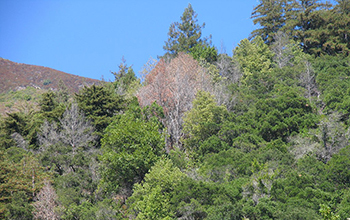
Research News
Model offers way to fight pathogen that causes sudden oak death
May 22, 2019
When a new, more aggressive strain of the pathogen that causes sudden oak death turned up in Oregon, scientists and stakeholders banded together to try to protect susceptible trees and the region’s valuable timber industry.
The disease has killed millions of trees in California and Oregon. The future is just as concerning. If sudden oak death were to spread from an isolated outbreak in Curry County, Oregon, to neighboring Coos County, for example, the impact could be severe: a 15% reduction in timber harvest, and the loss of 1,200 jobs and about $58 million in wages, according to an Oregon Department of Forestry report.
Researchers at North Carolina State University can now be of help, through an interactive model called Tangible Landscape. The model allows users to control complex simulations and explore scenarios.
“Responding to a disease outbreak requires collaboration among scientists who study the disease, professionals who fight it, and citizens who provide vital information,” says Sam Scheiner, a program officer in NSF’s Division of Environmental Biology, which funded the research along with USDA’s National Institute of Food and Agriculture. “This study offers a model for many kinds of threats to humans, agricultural systems and wildlife.”
The model allows users to factor in budgets for disease management to try out different approaches to stop the spread of sudden oak death.
“People can add objects to this 3D model of the landscape to represent different types of management, then with the click of a button see how that action may affect the disease’s spread,” says Devon Gaydos, lead author of a research paper in Philosophical Transactions of the Royal Society B.
“You can think of the model like a weather forecast: knowing what the weather may look like this afternoon can help you decide if you want to bring an umbrella to work,” Gaydos says. “And knowing how the pathogen may spread over the next year can help people figure out which areas to target for surveillance or management.”
—
NSF Public Affairs,
(703) 292-8070 media@nsf.gov
Source: NSF News
Brought to you by China News






